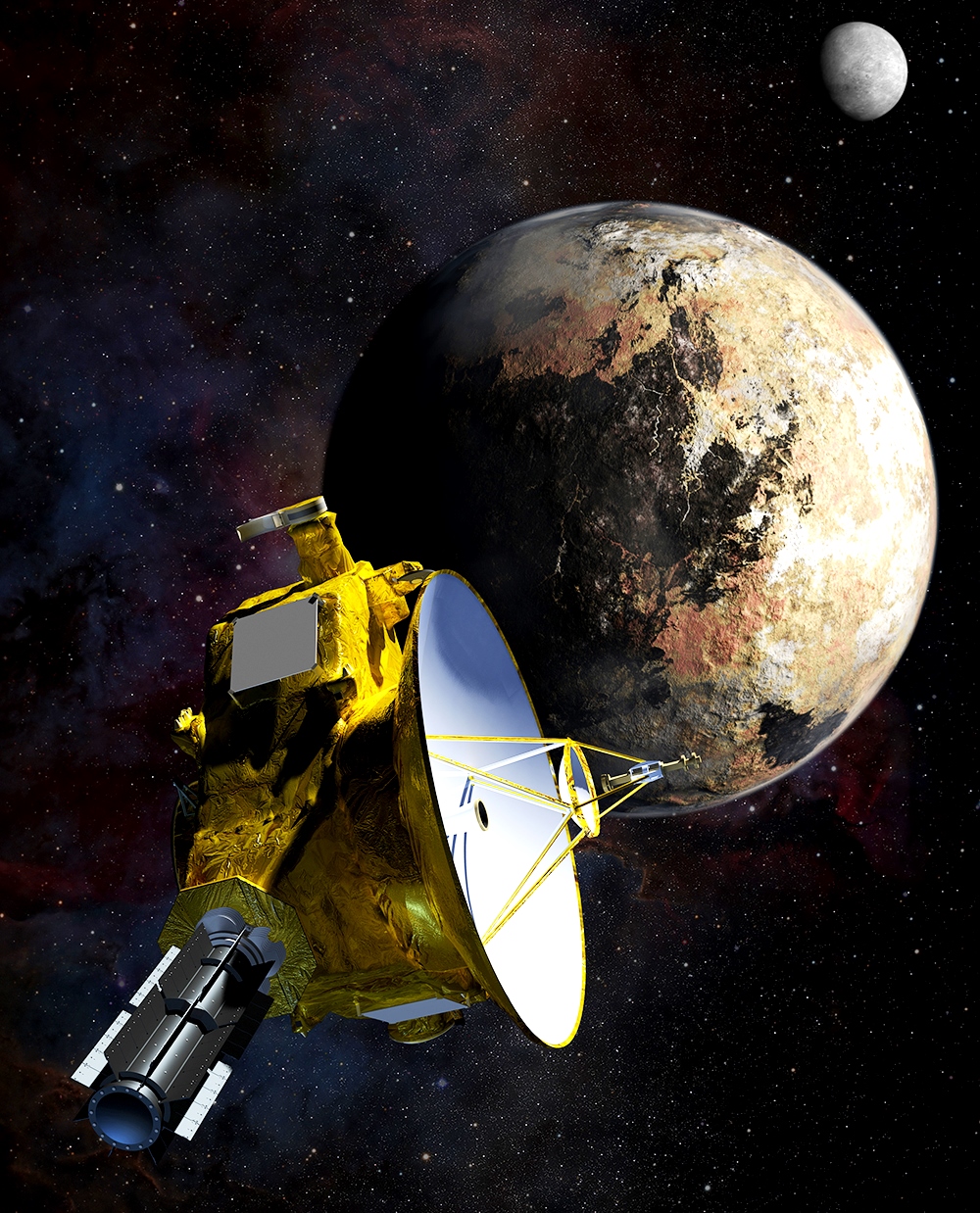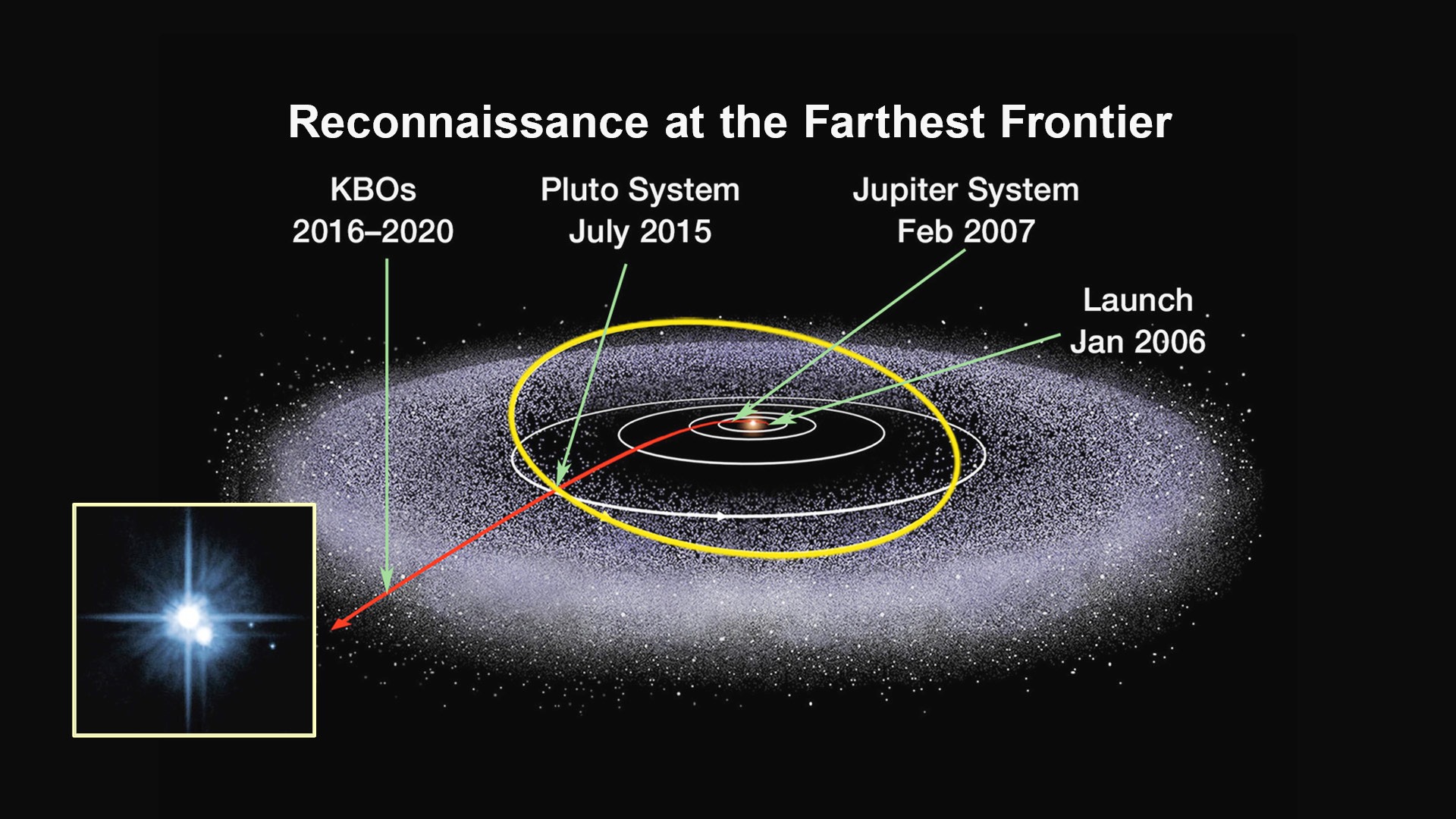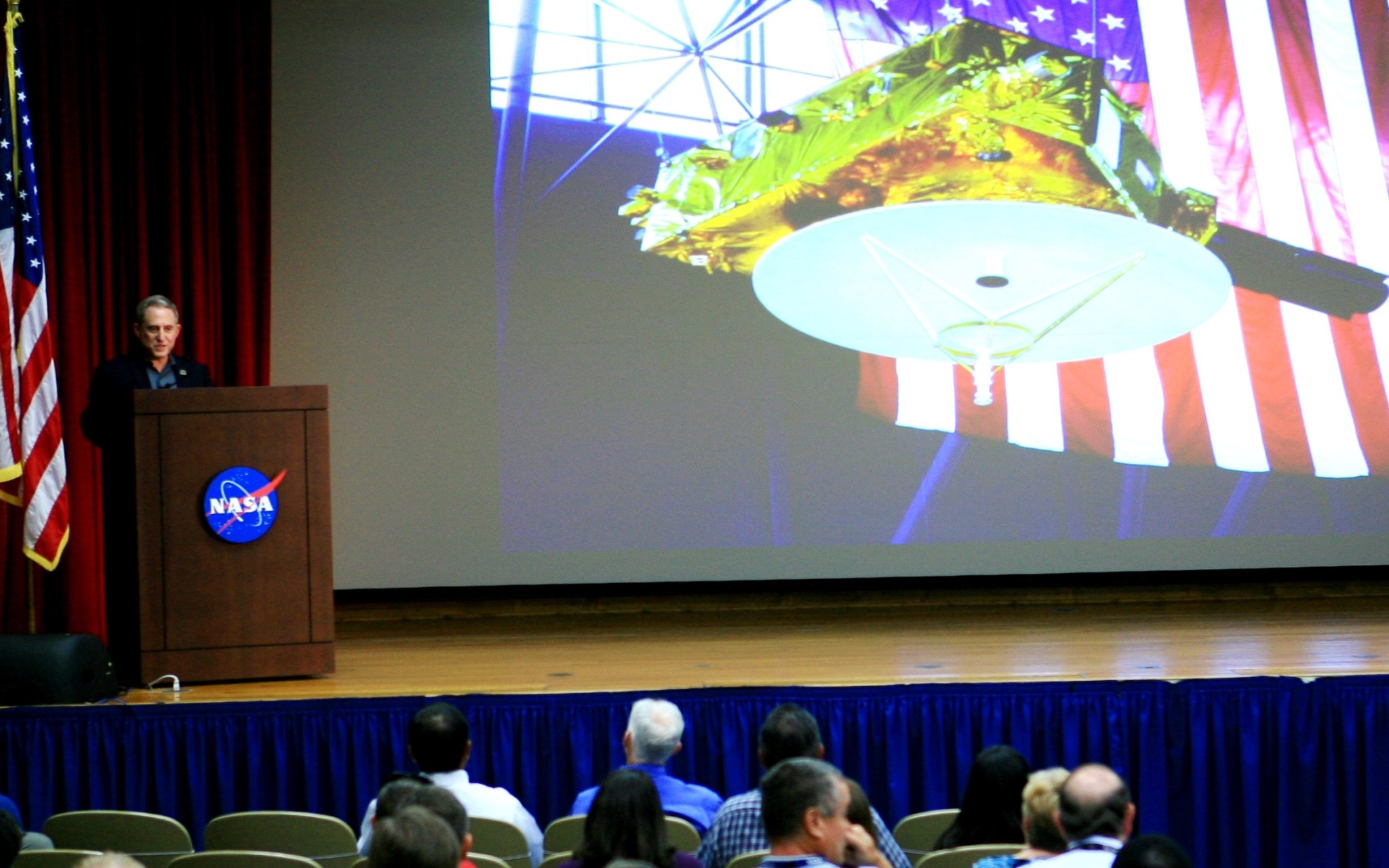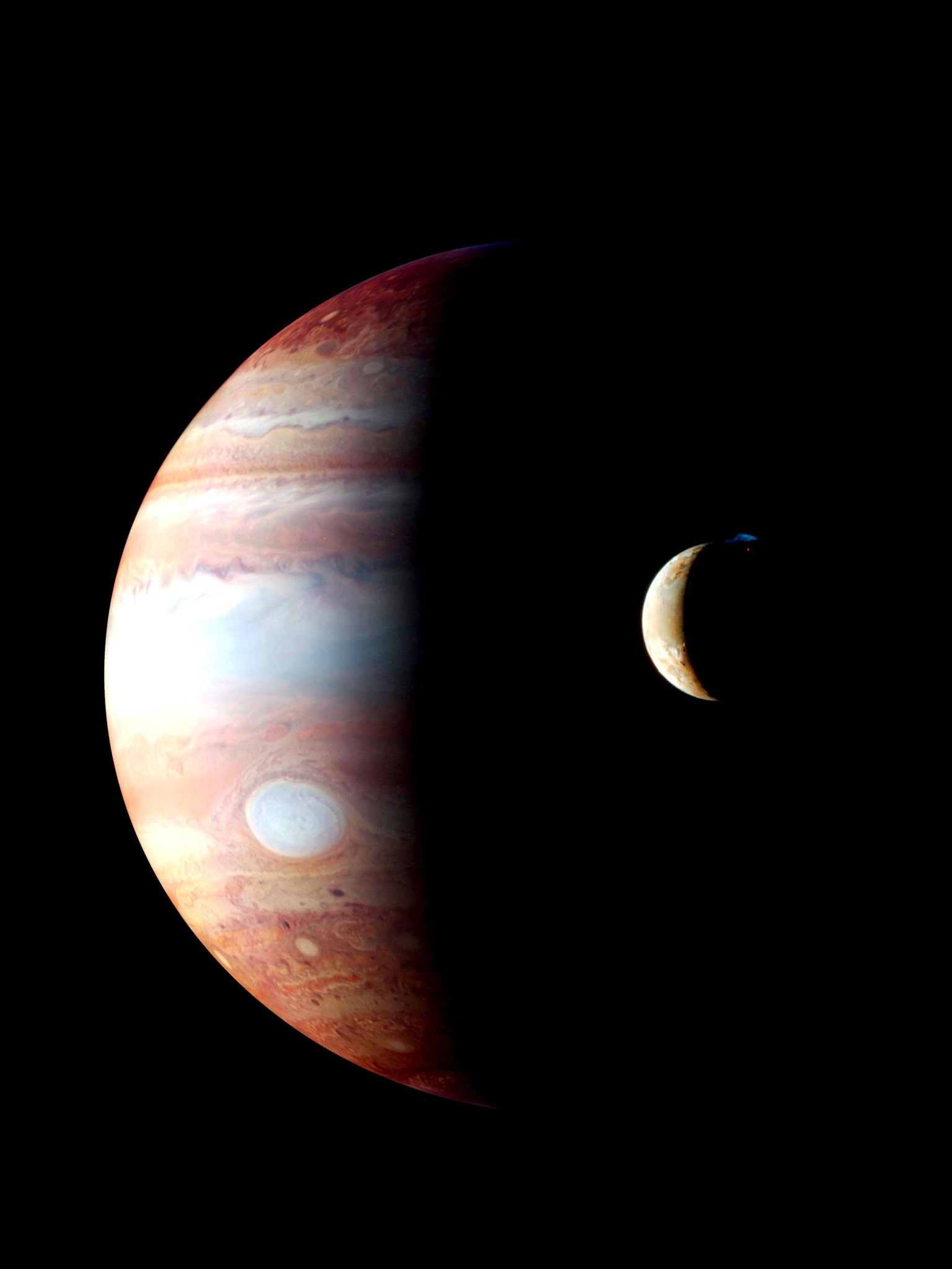NASA’s New Horizons spacecraft soon will pass through the outer edges of the solar system. After a nine year and more than 3.6 billion mile trip, plans call for the probe to provide the first close up observations of Pluto and the most distant objects in the solar system.
“Of course we’ve seen it before, but we’ve never seen it like we’re going to see it on July 14,” said NASA Deputy Administrator Dava Newman, Ph.D., during a recent visit to the Kennedy Space Center.
Lifting off from Cape Canaveral Air Force Station on Jan. 19, 2006, New Horizons has traveled a longer time and farther away than any previous space mission to reach its primary destination, Pluto and the Kuiper Belt.
On June 2, New Horizons principal investigator Alan Stern, Ph.D., spoke to Kennedy Space Center employees, providing a preview of what to expect when the spacecraft makes its closest approach to Pluto on July 14, 2015.
“It’s an epic journey across the solar system,” said Stern, who is associate vice president for Research and Development at the Southwest Research Institute (SwRI) in Boulder, Colorado.
The New Frontiers spacecraft was built by a team led by Stern and included researchers from SwRI and the Johns Hopkins University Applied Physics Laboratory (APL) in Laurel, Maryland. APL also operates the New Horizons spacecraft and manages the mission.
“Nothing like this has happened since the Voyager program launched in 1977,” said Stern.
During the mid-1960s, the United States and Soviet Union began sending probes to the planets closest to Earth – Venus and Mars. However, it was not until the 1970s that spacecraft were being launched toward Mercury, Jupiter and Saturn. The most significant step was Voyager 2, also referred to as the “Grand Tour.” Launched from Cape Canaveral in 1977, it passed Jupiter in 1979, Saturn in 1981, Uranus in 1986 and Neptune in 1989.
“I’m particularly proud of the tradition that began in 1962 with Mariner to Venus,” said Stern, a former associate administrator for NASA’s Science Mission Directorate. “The United States was first to every planet in the solar system. Centuries from now people will read about how, in one short period of time, a little over 50 years, we started from scratch eventually exploring across the solar system. But, we have a bit of unfinished business. New Horizons is going to complete that.”
New Horizons launched from Cape Canaveral on Jan. 19, 2006 directly into an Earth-and-solar-escape trajectory. After the spacecraft separated from its third stage solid-fuel kick motor 44 minutes, 53 seconds after launch, the Pluto probe was on its way at 36,373 mph. With that velocity, it needed only nine hours to pass through the moon’s orbit.
The planet Jupiter provided New Horizons with a gravity assist when it passed within 1.4 million miles on Feb. 28, 2007. A gravity assist maneuver puts a spacecraft in a trajectory close enough to a planet to use its gravity. This alters the probe’s path in a “slingshot maneuver” to change speed saving propellant and travel time.
The Jupiter flyby increased New Horizons speed, accelerating the probe to 51,000 mph and shortening its voyage to Pluto by five to six years.
During the Jupiter encounter, New Horizons trained its science instruments on the large planet and its moons. After that, Chuck Tatro, who was the New Horizons launch site mission manager for LSP, explains the spacecraft was placed in “electronic hibernation” for much of the trip to Pluto. New Horizons pioneered routine cruise-flight hibernation. Not only has it reduced wear and tear on the spacecraft’s electronics, it lowered operations costs and freed up NASA Deep Space Network tracking and communication resources for other missions.
“Throughout the almost nine-year trip, flight controllers would ‘wake up’ New Horizons once every year to confirm the health of the spacecraft and perform any needed course corrections,” he said. “It was brought out of its final hibernation period on Dec. 6, 2014 to prepare for the Pluto encounter this summer.”
When New Horizons’ closest approach to Pluto begins, the probe will perform a flyby during which it will attempt to take detailed measurements and images of the small planet and its moons.
“It will whiz by Pluto,” said Tatro, who currently is chief of the Launch Site Integration Branch of LSP. “The fly-by will last only eight to 10 hours. We’ll be receiving the bulk of the data during a period of about 24 hours.”
Due to the 3.625-billion-mile distance, it will take about four-and-a-half hours for the signals to reach Earth with the long-awaited information.
“The closest approach period really starts around the first of the month, (July 2015) and goes for several weeks,” Stern said. “About 900 scientific observations will be taking place.”
New Horizons is intended to pass within 6,200 miles of Pluto, at about 7:50 a.m. EDT on July 14. The spacecraft will have a relative velocity of 30,800 mph at its approach and will come as close as 17,000 miles to Pluto’s largest moon, Charon.
“This is true exploration,” Stern said. “We’re going to write the book on Pluto.”
Planetary scientists believe Pluto is primarily made of rock and ice and is relatively small, about one-sixth the mass of the moon and one-third its volume.

“Pluto is about the size of the United States,” Stern said. “Charon is about the size of Texas.”
Charon has a diameter just over half that of Pluto with the two sometimes described as a binary system. This is because the barycenter of their orbits do not lie within either body. The International Astronomical Union (IAU) has yet to formalize a definition for binary dwarf planets and Charon is still officially classified as a moon of Pluto along with Nix, Hydra, Kerberos and Styx.
When the New Horizons spacecraft was launched, Pluto was still classified as a planet, later to be reclassified as a dwarf planet by the IAU. Stern disagrees with that definition and still describes Pluto as a planet.
“We’re just learning that a lot of planets are small planets and we didn’t know that before,” he said. “Fact is, in planetary science, objects such as Pluto and the other dwarf planets in the Kuiper Belt are considered planets and called planets in everyday discourse in scientific meetings.”
Pluto’s orbital period is 248 Earth years and its orbital characteristics are substantially different from those of the planets. From Mercury to Neptune, the other bodies circle the sun following nearly circular, almost flat, orbits. In contrast, Pluto has an eccentric and highly inclined orbit that takes it from 2.8 to 4.6 billion miles from the sun. Hence, Pluto periodically comes closer to the sun than Neptune, but their orbital resonance prevents the bodies from colliding.
Tatro noted that for the past nine years, Pluto’s 3.625-billion-mile distance from the sun gives a rare opportunity to determine the nature of any atmosphere.
“Due to this ‘relative closeness’ to the Sun, scientists feel this provides the best hope of detecting any type of atmosphere around Pluto,” he said. “This is because of the sun’s weak heating at this ‘closer’ distance.”

After its flyby of Pluto, New Horizons may also open the door to an entirely new zone of mysterious small planets and planetary building blocks in the Kuiper Belt, a large area with numerous objects beyond Neptune’s orbit.
“Gerard Kuiper, who was a leading 20th century planetary scientist, believed that the reason Pluto looked like a misfit was that our technology was not good enough to find things orbiting with it,” Stern said.
The Kuiper Belt is a region of the solar system beyond the planets, extending beyond the orbit of Neptune. It is similar to the asteroid belt, but it is much larger — 20 times as wide and 20 to 200 times as massive. Like the asteroid belt, it consists mainly of small bodies, or remnants from the solar system’s formation.
By expanding the frontiers of knowledge, capability and opportunity in space, NASA hopes to better understand the farthest reaches of the solar system, answering questions about Earth and life beyond.
“The universe has a lot more variety than we thought about and that’s wonderful,” Stern said. “The most exciting discoveries will likely be the ones we don’t anticipate.”




























